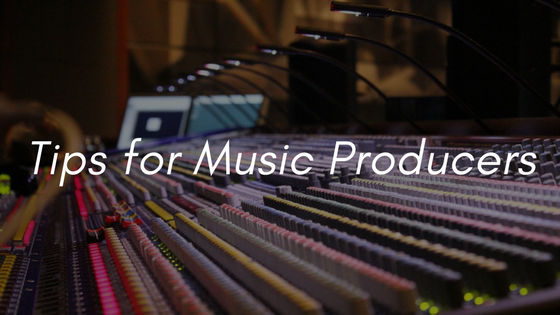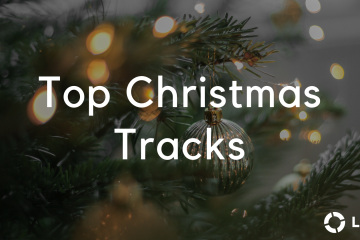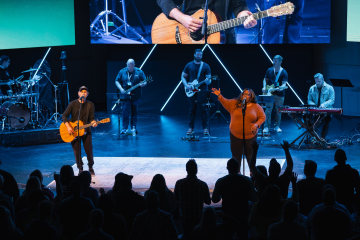Tips for Music Producers

Whether producing music is a job or a hobby for you, there are always challenges of how to get the best mix of all your instruments. At Loop Community, we want to help worship leaders create the best tracks they can. No matter what music recording software you use, check out these tips that can really boost the sound quality of your tracks!
Drums:
1. Control the amount of overheads you need in a mix. The most dominant instruments of the drum is the kick and snare, while the toms sit between the mix of overheads, kick, and snare.
2. If you want the kick to complement the bass guitar, you’ll need to look in the frequency spectrum and choose the pocket of frequencies that you want for the kick. So, if the kick’s sub frequency sits around 30-60Hz and the bass guitar sub sits around at 60-80Hz, you’ll need to attenuate the kick for anything above 60Hz in order to leave space for the bass guitar. If the kick frequencies overlap with the bass guitar, also known as “masking”, it won’t sound good. Leave space for the instruments!
3. If you recorded the top snare and don’t like the sizzle of the bottom snare, use side-chain gating on the snare with a white noise oscillator plugin that comes on every DAW. This is cool for whenever you hit the snare, because the white noise activates each hit and then ducks down right away because the gate is also activated.
4. If you use virtual drum plugins, be very careful with the velocity of each hit. Personally, I don’t want to buy a song if the drums sound robotic because it’s really unnatural. Listen to the original song you’re covering, catch the meticulous part of the hits, and try to copy the sound as much as you can on those hits. When you listen to your track, close your eyes, and see if you feel like there’s an actual drummer in the room.
5. Always use a click!
Percussion:
1. This is probably the easiest instrument to mix. The frequencies are high enough so they don’t tend to interfere with other instruments.
2. Whenever you do an acoustic song, make sure to add more percussion instruments to fill in the mix.
3. Don’t be afraid to increase the volume a bit. Percussion instruments can get lost if they are too quiet.
Bass Guitar:
1. It’s important that you hit the notes right on the grid of your DAW. This technique is easier if you’re a bit behind the tempo instead of playing ahead. Relaxing your muscles to relieve the tension in your hands can also help you hit the notes on the grid.
2. The fundamental frequency for bass guitars is around 40Hz-400Hz and the harmonics are around 4kHz-5kHz. Just like with drums, leave frequency space for other instruments to play around with.
3. Tune, tune, and oh yeah… Tune! No matter how quiet or how loud the bass is, it will always be heard. Don’t press, pluck, or pick the strings aggressively. This can cause it to go out of tune. Let the electric players do the hard work while you chill and maintain balance giving your bass the best sound possible.
Electric Guitar:
1. Electric guitar tends to be the instrument that stands out the most. Be conservative with the way you mix as electric guitars are midrange sensitive. Humans tend to hear the midrange frequencies the most, so be careful how much you use. Leave space for the keyboard to complement it in the mix as well.
2. The muddy and muffled frequencies are around 250Hz-700Hz. If you want the lead guitar to cut in the mix, try boosting it to around 2kHz-4kHz. 2.3kHz is the sweet spot for me. If you want to add some meat to the tone, mess around with the EQ between 90Hz-120Hz.
3. Guitar effects are key to coloring your sound on electric, but be careful with the number of effects you add or it will sound mushy!
Acoustic Guitar:
1. The acoustic guitar is often underestimated. It can give personality to worship leaders that sing and it’s the one instrument that can sound like a guitar and be percussive. I suggest having an acoustic guitar ready for any song.
2. When you record an acoustic guitar, make sure it’s an acoustic-electric guitar. That way, when you record the acoustic you are picking up the signal from a microphone and getting the direct line in for its second channel. People tend to push direct lines away since it can sound unnatural, but it can actually help give body to the sound and get rid of the airy, high end sound that sometimes comes from a microphone.
3. My preference for EQ-ing is to cut any sub frequencies so that all the rumble and background noises are removed. The acoustic can’t reach those frequencies anyways. I usually remove 100-250Hz since that’s where all the rumble comes from, and 10-20kHz should also be filtered out if you want to remove any hissing noises in the background. The full guitar frequencies start at around 50-80Hz, add in 200-300Hz if you want more body to the guitar, and around 2-5kHz is where you get the definition of the strings.
Keys:
1. Be creative! Our job as musicians is to expand our horizons with the effects and samples you put in the instrument.
2. Remember keys and electric guitar share the same frequency at times. Let these two kids play fair by sharing the frequency spectrum.
3. The keyboard can provide a lot to help your sound, from the lowest of subs and synth basses to high glassy synth pads. When you are finished recording the keyboard tracks, listen to them altogether to see if something is missing. Does it feel empty? Are there too many synth sounds? Keep working to find a good balance and you’ll be able to create great sounding tracks.
BGV (Background Vocals):
1. People like BGVs! Adding two or three BGVs can help a lot with filling certain parts of the mix.
2. Vocals tend to sit around the 250-600Hz, which is awesome since most instruments around those frequencies tend to sound muddy.
3. Side-chain compressions are great for BGVs whenever you want the instruments to duck down a bit to leave space for the vocals to sing.
I hope these tips help you as you produce your next track. Leave any questions below, and if you’d like to apply to be an LC Contributor, fill out the application!

Robert Titean is an audio engineer and producer from Chicago, IL. He creates his own tracks and contributes them to the community. He also serves at Harvest Bible Chapel and the Vertical Church Band.



3 Comments
Adam Riley · November 30, 2017 at 12:08 pm
This was great! Do you have any VIDEO tutorials that implement these methods and show exactly how to create tracks using each instrument and letting us see exactly what you’re doing in Ableton Live? (Screen Recording) I’m also curious if there can be a tutorial on recording electronic drums in Ableton Live (hooking the module up to computer and mapping each trigger appropriately) so you can hit the snare drum and send MIDI to Ableton to get any snare sound you want, then hit the kick etc…
Loop Community · December 5, 2017 at 1:26 pm
Great ideas! We will see if we can get some tutorial videos recorded for some of these tips.
Taylor Bishop · February 12, 2019 at 8:36 am
I wanted to thank you for these tips for music producers. It’s good to know that for drums you should control the amount of overheads you should have in a mix. I’m interested to learn if you should test the drums before a recording so you have an idea of how much overhead is needed.